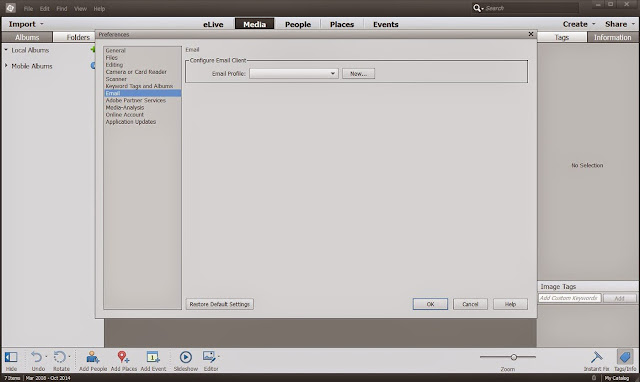Recently in a forum discussion mention was made about Premiere Elements 10 not supporting AVCHD 1080p60. True, there is no AVCHD 1080p60 project preset in version 10 as there is in versions 11, 12, and 13.
ISSUE
There is a fine line between "non support" of AVCHD 1080p60 in Premiere Elements 10 and Adobe just not including that particular project preset in its lineup of project presets.
SOLUTION
The Premiere Elements 10 user can create a Premiere Elements 10 AVCHD 1080p60 project preset, import a 1080p60 source video into a Premiere Elements 10 project set with that user created project preset, edit the 1080p60 Timeline content, and export that 1080p60 Timeline content to an AVCHD 1080p60 file. The how to for this will be given in the next section How To. The new AVCHD 1080p60 file will be created by editing the Notepad document of the existing project preset AVCHD LITE 720p60.
HOW TO
Creation of the AVCHD 1080p60 Project Preset
STEP 1.
Finding the AVCHD LITE 720p60.sqpreset to Edit it to AVCHD 1080p60.sqpreset
Follow the path
Local Disk C/Program Files/Adobe/Adobe Premiere Elements 10/Settings/SequencePresets/NTSC/AVCHD
In the AVCHD Folder, find the file named AVCHD LITE 720p60.sqpreset, right click it, select copy, and paste the copy to the computer desktop.
STEP 2.
Editing the AVCHD LITE 720p60.sqpreset
On the computer desktop, right click the AVCHD LITE 720p60.sqpreset file, select Open With, and then Notepad. The edits in the AVCHD LITE 720p60.sqpreset necessary to obtain the AVCHD 1080p60.sqpreset are
1. Two EditingModeGUID Lines Changes
From:
<EditingModeGUID.Win>fcf18658-5378-4d31-96b1-12fe7071f5a1</EditingModeGUID.Win><EditingModeGUID.Mac>fcf18658-5378-4d31-96b1-12fe7071f5a1</EditingModeGUID.Mac>
To:
<EditingModeGUID.Win>088bb726-9823-467e-b3b7-26f3703d4cf1</EditingModeGUID.Win><EditingModeGUID.Mac>088bb726-9823-467e-b3b7-26f3703d4cf1</EditingModeGUID.Mac>
Figure 1 shows after editing change for these two lines.
 | |
| Figure 1. AVCHD LITE 720p60 NotePad Document. EditingModeGUID Lines After Edit |
2. </DescriptionItem> for User Language
(In this example, Language is English for United States)
See immediately after the EditinModeGUID lines.
From: 1280 x 720
To: 1920 x 1080
From: 720p
To: 1080p
Figure 2 shows after editing changes for United States (also started to do the same for France).
 |
| Figure 2. <DescriptionItem>, AVCHD 1080p60 After AVCHD LITE 720p60 Notepad Document Edit |
3. </NameItem> for User Language
(In this example, Language is English for United States)
See immediately after section on </DescriptionItem>
From:
</NameItem>
<NameItem Version="1" Index="0">
<Second>AVCHD 720p60</Second>
<First>en_US</First>
To:
</NameItem>
<NameItem Version="1" Index="0">
<Second>AVCHD 1080p60</Second>
<First>en_US</First>
4. </Name>
See immediately after section on </NameItem>
Only the following line needs changing
From:
<VideoFrameSize>0,0,1280,720</VideoFrameSize>
To:
<VideoFrameSize>0,0,1920,1080</VideoFrameSize>
The after edited <./Name> area is seen in Figure 3.
 |
| Figure 3. </Name>, AVCHD 1080p60 After AVCHD LITE 720p60 Notepad Document Edit. |
Placing the new AVCHD 1080p60.sqpreset in the NTSC Folder along with the other Adobe .sqpreset files.
Move the newly created AVCHD 1080p60.sqpreset file to the AVCHD Folder in the path
Local Disk C/Program Files/Adobe/Adobe Premiere Elements 10/Settings/SequencePresets/NTSC/AVCHD
After that is done, the project preset AVCHD 1080p60 will be available in Premiere Elements 10 New Project dialog under NTSC/AVCHD with a valid description. See Figure 4.
 |
| Figure 4. Premiere Elements 10 New Project Preset Displaying Newly Created AVCHD 1080p60 Project Preset. |
When the AVCHD 1080p60 project preset is selected, the project settings as reflected in Edit Menu/Project Settings/General will be the correct ones for AVCHD 1080p60. See Figure 5.
 | ||
| Figure 5. Premiere Elements 10 Edit Menu/Project Settings/General With Newly Created AVCHD 1080p60 Project Preset. |
STEP 4.
Suggested Export of the Timeline 1080p60 to a 1080p60 File Save to the Computer Hard Drive
Share
Computer
AVCHD
with Presets = MP4 - HD 720p60
then, under the Advanced Button/Video Tab, customize the preset to 1080p60.
See Figure 6.
 | ||
| Figure 6. Premiere Elements 10. Export Of 1080p60 Timeline Content Using New Created AVCHD 1080p60 Project Preset And Export To AVCHD.MP4 1920 x 1080 @ 59.94 Progressive Frames Per Second. |
The playback quality of resulting AVCHD.mp4 using Window Media Player 11 on Windows 7 64 bit was excellent.
COMMENTARY
From the project preset side of things, if the user is not doing a frame by frame by frame editing of a 1080p60 source video, the DSLR settings for NTSC 1080p30@ 29.97 can be used and the frame rate matter dealt with in export.
One should not be forced to go to a later version for editing a 1080p60 video source in Premiere Elements 10.
ATR

